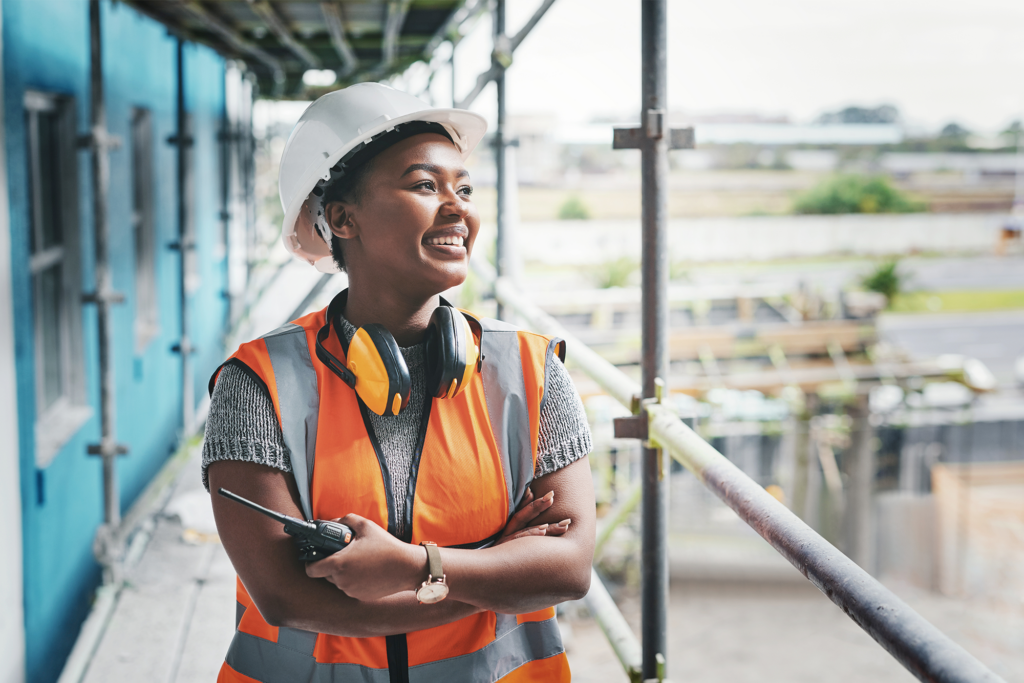Personal Protective Equipment Considerations for Women in Construction

Historically, the construction industry has largely been a male-dominated field. In fact, according to the U.S. Bureau of Labor Statistics, women currently account for just 10.3% of those employed within the sector—a statistic that has been relatively steady for much of the past two decades. As a result of this workforce trend, many suppliers and manufacturers have refrained from producing and selling personal protective equipment (PPE) tailored for women, thus prompting construction employers to adopt a “one-size-fits-all” approach and have these employees wear PPE made for men.
Nevertheless, this approach poses significant safety concerns. Wearing PPE that fails to accommodate women’s anatomical differences and isn’t correctly fitted to their bodies could not only cause them discomfort on the job, but also make them increasingly susceptible to worksite accidents and associated injuries and illnesses. Especially as a growing number of construction employers explore untapped demographics and recruit more women to join the field to help combat widespread labor shortages, it’s vital that they provide inclusive PPE. This article offers more information on the importance of properly fitting PPE for women in construction and outlines best practices employers can follow to ensure sufficient PPE for these workers.
The Importance of Properly Fitting PPE
When women have to wear PPE that’s made for the opposite sex and fits poorly, they could experience a wide range of consequences. Even using similarly sized PPE tailored for men or unisex alternatives are unlikely to adequately account for physical differences in women’s body shapes and extremities. Namely, women typically have smaller waists, hands and feet;shorter arms and legs; and wider hips than men. Here are some common safety hazards that women in construction may encounter from wearing various ill-fitted PPE:
Amputations and fatalities—If high-visibility clothing and safety gloves fit women poorly—particularly if they are too loose—they could be more likely to get caught in worksite machinery and tools, potentially resulting in amputations or (in severe cases) fatalities.
Slips and trips—In addition to ill-fitted safety footwear (e.g., steel-toed boots) possibly causing women’s feet to blister,it’s important to note that men’s shoes are often heavier than those of the opposite sex. As such, wearing men’s safety footwear and carrying extra weight on their feet could increase women’s occupational slip and trip exposures.
Falls from height—Poorly fitting PPE utilized when working from height, such as personal fall arrest systems, may not distribute weight evenly across women’s bodies, primarily in the waist and hip areas. This could render such systems ineffective, therefore elevating the likelihood of women falling from height and experiencing serious head and neck injuries on the job.
Respiratory complications—If respirators don’t fit women correctly, they could restrict access to clean air and expose these workers to any respiratory irritants present at the worksite (e.g., hazardous chemicals and dusts). This could lead to long-term respiratory complications, such as occupational asthma or lung cancer.
Apart from these safety hazards, the discomfort created by ill-fitted PPE could distract women from tasks at hand and even prompt them to avoid wearing PPE altogether, substantially driving up overall accident exposures. Fortunately, as more women join the construction sector and PPE pitfalls become increasingly apparent, certain suppliers and manufacturers have taken notice and begun offering PPE tailored to this demographic.
Best Practices to Ensure Sufficient PPE
Moving forward, it’s crucial for construction employers to provide inclusive PPE for their workers to prevent potential safety risks, especially those stemming from women wearing ill-fitted PPE made for the opposite sex. Employers can consider these best practices to maintain sufficient PPE across demographics:
Maintain OSHA compliance. Current OSHA guidance states that PPE utilized by women “should be based upon female anthropometric (body measurement) data” and “PPE must fit properly so that it can effectively protect the employee from the hazard for which it was designed.” Additionally, OSHA is in the process of issuing a proposed rule that may result in more robust standards for employers to ensure all workers receive adequately fitted PPE. With this in mind, construction employers should regularly assess their PPE policies and procedures and revise them as needed to comply with the latest OSHA guidance and requirements.
Be proactive. Employers shouldn’t wait for their workers to make complaints regarding ill-fitted PPE or related accidents to occur. Rather, they should focus on preventing these problems before they can start by proactively purchasing PPE insize ranges that accommodate women. They can do so by working with trusted suppliers and manufacturers that provide PPE in a wide selection of sizes catered to varying demographics. Employers should also make it a priority to always keep PPE of diverse size ranges available on-site, provide workers with direct access to such equipment, facilitate routine PPE fit-testing, and conduct comprehensive training on how to properly use this equipment and determine whether it fits correctly.
Promote inclusivity. In order to uphold a safe work environment, construction employers should go beyond simply purchasing PPE tailored for women. Inclusivity entails recognizing that all workers’ bodies are unique, and their specific PPE needs may vary based on a variety of factors, including sex, height, weight, physical abilities and even cultural differences. This means that, in addition to providing PPE made for women, employers should ensure they make the following PPE options available:
Maternity PPE catered to pregnant workers
High-visibility clothing for workers of all heights
Safety gloves and footwear for workers who require extra small and extra large sizes
PPE tailored to workers who use wheelchairs or have limb differences
PPE for workers with particular cultural or religious needs (e.g., equipment that coordinates with a Muslim woman’s hijab)
It’s evident that one size does not fit all when it comes to PPE. By offering inclusive PPE for their workers, construction employers can make all the difference in promoting a safe work environment, mitigating accidents, and limiting occupational injuries and illnesses. For additional industry-specific risk management guidance, contact us today.
For more construction safety tips, contact INSURICA today.







